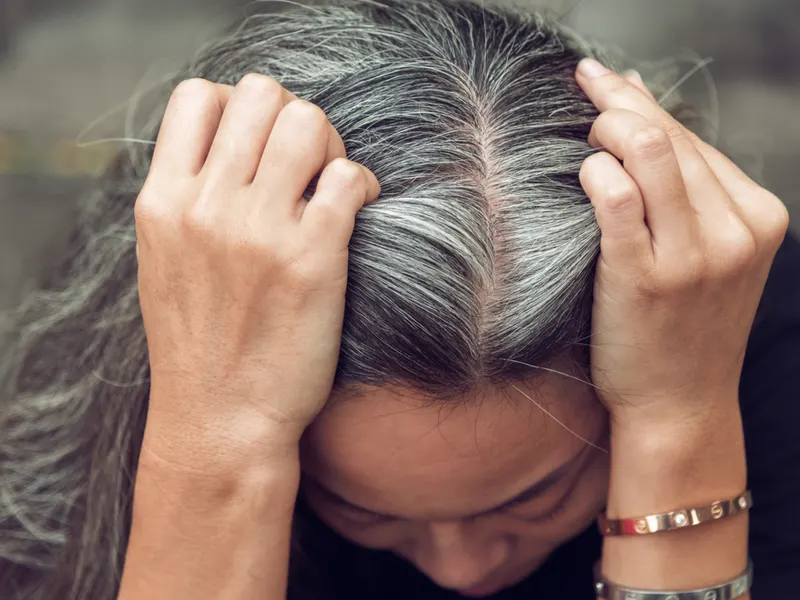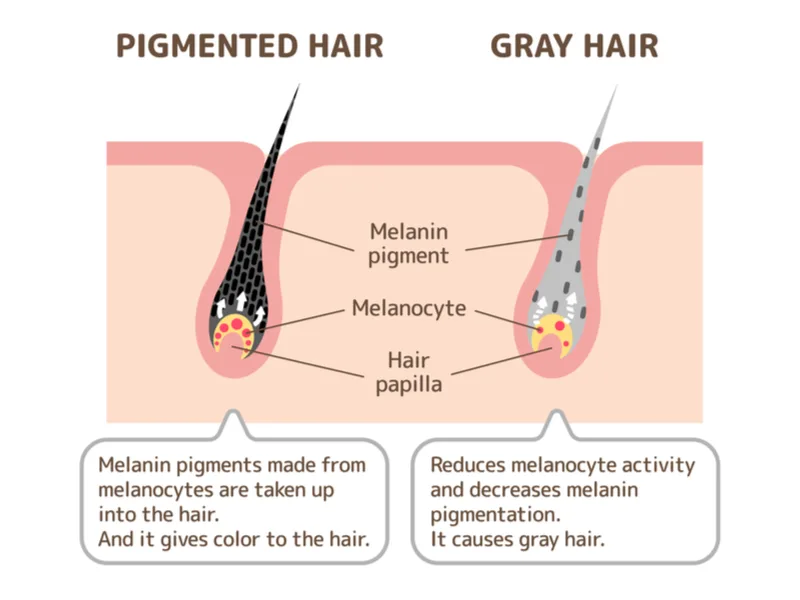Jump to:
At-home color treatments are an excellent way to cover up greys, as long as you know what you’re doing. If your hair’s resisting even your best efforts, you’re probably wondering, “Why won’t my grey hair dye?” Today, we’re going to spell out everything you need to know.
Why Won’t My Grey Hair Dye?

Waewkid/Shutterstock
Grey hair is often more challenging to dye than regular hair for a couple of reasons. It has a coarser texture, and grey hair follicles also tend to be drier, as they produce less oil. Because of this rougher surface, color has a tougher time penetrating these hairs.
So if you’ve been having a hard time achieving the color you want, know that the problem isn’t just in your head. Grey hair does what it wants, and it’s often less than cooperative.
Many people find that leaving the dye on their greys for longer is the only way to cover them, but this practice can be incredibly damaging. Thankfully, you don’t have to live with your greys if you don’t want to; you just have to know how to tame them.
To help you do that, we’re going to cover some grey color best practices, like:
- A closer look at how grey hair is different than non-grey hair
- Need to know tips and tricks
- How to color grey hair at home
- How to make your color last
Keep reading to learn more.
How the Aging Process Affects Hair

Barks/Shutterstock
Before talking about how to dye grey hair, it’s helpful to understand how the aging process and what exactly causes grey hair.
Changes in Texture
As we age, hair follicles produce less melanin, a pigment that gives hair its color. Grey hair is one result of having less melanin. Another side effect is that the protective layer surrounding hair (called the cuticle) becomes thinner, which causes it to become coarse and wiry.
Less Protection
Because the cuticle is thinner, it also provides less protection from the elements. Grey hair is much more susceptible to damage from things like heat styling, ultraviolet rays, chemicals, and humidity.
Dullness
Grey hair follicles produce less oil, which in theory might seem like a good thing, but in practice has negative effects. This oil actually functions as a natural conditioner for your hair, providing nourishment and protection from the elements.
It’s also the reason that non-grey hair has a more natural luster. When greys show up, oil production decreases, and dullness soon follows. You may also notice that your hair is stiff and dry.
Increased Breakage
Given all these factors, you probably won’t be surprised to learn that grey hair is inherently more fragile. It’s much more prone to breakage than hair with pigment is, which is why it’s essential to treat grey hair with respect. Adding a grey-specific shampoo can go a long way towards improving the health of silver locks.
You Might Also Like:
- How to Cover Gray Roots Between Salon Visits
- How to Grow Out Gray Hair That Is Colored
- How to Transition to Gray Hair From Lowlights
How to Color Grey Hair: Tips & Tricks
By now it’s clear that grey hair requires special care, especially when it comes to coloring. Whether you’ve been covering your greys for years or it’s your first time, it’s helpful to understand some basic tips and tricks.
Gauge Your Goals & Commitment Level
Do you want to completely cover your greys, or are you just looking to disguise it a bit? Are you willing to treat your hair every four to six weeks, or can you go longer between sessions? Understanding your goals and commitment level is critical, as this will determine the best treatment method.
When it comes to covering or disguising greys, not all options are created equal. Here are the differences between the most common methods:
- Permanent color: Permanent color is the best choice if you’re looking for total coverage. It’s long-lasting and better able to maintain its shine over grey hair. However, it requires frequent maintenance.
- Semi-permanent color: If you’re looking for a less dramatic change for your grey hair, a semi-permanent color is probably right for you. It makes a subtle difference in hair color, and it fades out nicely, so you can go longer between sessions if you want.
- Balayage/highlights: This option is best left to the professionals, but it’s worth mentioning. Both balayage and highlights are excellent ways to blend greys. They draw the eye to areas where there is a reflection, distracting from greys.
Prep Your Hair
Never underestimate the importance of prepping your hair for a dye job, especially when trying to cover greys.
- Use a shower filter: Did you know that the minerals in our water sources can make it hard to get the color you’re after? They slow down the bleaching process and stop the color from processing the way it should. Investing in a shower filter is the best way to remove minerals from your water.
- Wash your hair: If there’s a lot of build-up or grease in your hair, it’ll be even harder for the dye to penetrate your greys. Make sure to wash about 12 to 24 hours before coloring. You’ll have clean hair, but there will still be some oils on the scalp to protect against irritation.
- Perform a patch test: When using a new color, it’s best to perform a patch test first. You put a small amount of dye on an inconspicuous strand of hair, which serves two functions: it shows you what the dye will look like, and it lets you know if you’ll have any allergic reactions to it.
- Get the right tools: Set yourself up for success with the right tools for the job, especially if you plan to dye your hair often. One of those is a plastic bowl, which is easier to put dye in than the bottle that most dyes come in. You should also pick up an applicator brush, a tool that allows you to get the color everywhere you want it.
- Section your hair: One of the best ways to make a mess is to apply dye without sectioning your hair. Make sure to brush out all tangles and knots, then split your hair into four sections: top and bottom, left and right. Use a clip to secure each one, and dye by section.
Choose a Product with the Right Ingredients
It can be hard, but try to find a hair dye with no ammonia. Ammonia causes damage to the cuticle and is super harsh on the hair. Sure, it’s excellent at coloring, but it’s often not worth the damage it causes.
Instead, try to find a product with ingredients that nourish and strengthen the hair. Think of things like keratin treatments (for grey hair, specifically) and shea butter, which can help keep your locks feeling silky, despite the dyeing process.
Keep Things Light
No, we’re not talking about the color; we’re talking about the room you’re working in. It’s best to color your hair during the daytime so you have natural light to see what you’re doing, and you should also turn on the lights.
Respect Application Times
Patience is the name of the game when it comes to getting the right color. Only dye your hair if you have enough time to leave the application for the recommended time. Keep a timer on hand to make sure you leave the dye on long enough.
Think About Where to Place Color
When your roots grow out, it’s a good idea to only apply color to visible greys instead of throughout the rest of your hair. All-over color can look fantastic initially, but after several months, you’ll have color buildup on the ends. You’ll likely end up with an even darker color than you intended.
How to Make Color Last

Roman Samborskyi/Shutterstock
No one wants to spend more time (and money) than absolutely necessary doing salon or at-home treatments. Here are some tips to make your color last.
- Delay shampooing: The dye process actually extends beyond the time it’s sitting on your head, taking up to 24 hours to settle in. Don’t immediately shampoo your hair after dying it, as you may inadvertently fade the color. If you want to wash your hair, only use cold water.
- Wash less: Reducing the number of times per week you wash your hair can also help maintain your color for longer. Shampooing every day strips hair of oils and colors, so it’s best to space your washes. If things start getting greasy between showers, invest in a good dry shampoo.
- Avoid hot water: Sure, hot showers feel great, but they strip moisture right out of skin and hair. Hot water is also the enemy of your recent dye job, as it can make the color look dull. It may be difficult, but lower the water temperature a bit when you wash your hair. Your dye will thank you.
- Use color-specific hair products: Anyone who’s colored their hair knows that regular dying sessions can leave their locks feeling fragile. To keep hair soft and looking beautiful, it’s worth investing in products specifically for color-treated hair, otherwise even the best dye jobs can look lackluster. Try adding some hair oils and deep conditioning masks to your routine.
- Focus on the right places: Did you know that you should focus shampoo on your roots? Doing so will give you the best clean, and it will avoid stripping color from the mid-to end-range of your hair.
Frequently Asked Questions
Still having trouble getting your grey hair to dye? You may find this additional questions and answers helpful.
How often should I dye my grey hair?
It depends on how much your grey hair bothers you. To prevent visible greys, you’ll need to touch up your hair every four to six weeks.
Can you dye grey hair any color?
You can color your greys in plenty of different ways. Some people opt for medium browns, others go with dramatic platinum blonde colors, and still others prefer dark black. The choice is yours and will depend greatly on your natural hair color and skin tone.
Is going lighter or darker better when covering grey hair?
Everyone has different preferences about hair color, but going slightly lighter than your natural hair color often yields the best results. You may also consider going blonde, as blonde tones are easier to achieve on grey hair; they’re quite similar in color, after all.
Can you highlight grey hair?
Just because you have grey hair doesn’t mean that your highlighting days are over. Grey hair can indeed be highlighted, and the goal is to blend the silver locks with the lighter color of the other strands of hair.
What determines when you go grey?
The most significant determiners of when you go grey are genetics and natural aging. However, certain lifestyle factors like smoking, stress, and a poor diet can cause premature greying.
So, Why Won’t My Grey Hair Dye?
So, why won’t your grey hair dye? Now you know that grey hair presents different challenges than regular hair. Its thinner, coarser nature requires some slight adjustments to at-home dying methods, but hopefully, our tips have given you the tools needed for success.
